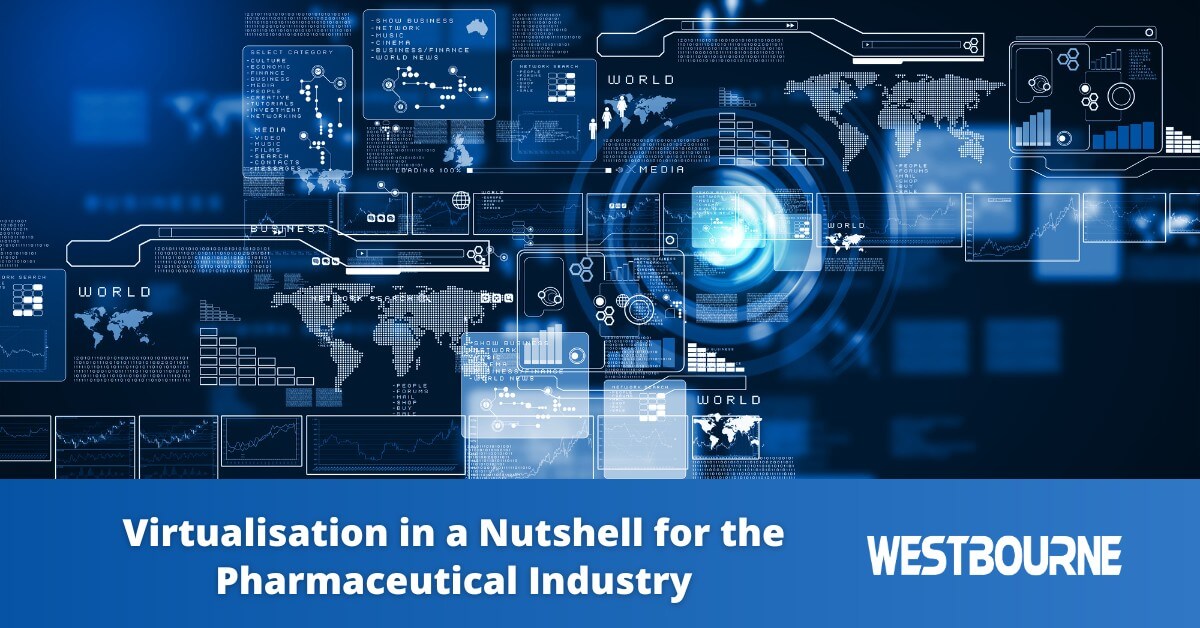Virtualization in a nutshell

Traditionally, IT infrastructure was physical, i.e., physical servers in an on-site server room, physical desktops on each lab technician’s desk/workstation, etc. Virtualization technologies create virtual representations of these previously physical IT infrastructure elements. In other words, virtualization technologies mimic the functionality of physical hardware. The result is one physical machine running multiple virtual instances.
So, in essence, virtualization involves replacing physical hardware with software representations.
We can use an example of a workstation in a pharmaceutical lab environment. The traditional approach would involve having a physical computer that could have an operating system, LIMS application and/or Chromatography Data System (CDS) application, Microsoft Office, and other apps. With a virtualization approach (such as VDI – virtual desktop infrastructure), the workstation would instead have a virtual desktop with the operating system and applications served to the user from a server or the cloud.
In other words, there is no longer a need for the physical computer at the workstation. Furthermore, the server or cloud-based solution can run multiple virtual desktops at the same time.
The Different Types of Virtualization
- Server virtualization – where a single physical server is partitioned into multiple virtual servers, each running its own operating system and applications.
- Storage virtualization – where multiple physical storage devices, such as hard drives, are combined into a single virtual storage pool.
- Network virtualization – where multiple virtual networks operate on a single physical network infrastructure.
- Data virtualization – where data from multiple sources is combined into a single, logical view, without physically moving the data.
- Application virtualization – where applications run in a virtual environment isolated from the underlying operating system and other applications on the same system.
- Desktop virtualization – also known as VDI, desktop virtualization allows a desktop operating system to run in a virtual environment, hosted on a server or data center, and accessed remotely by users on their devices.
The Benefits of Virtualization for the Pharmaceutical Industry
Consolidation
Virtualization reduces the amount of physical hardware that you need to own, maintain, and manage. This reduces IT infrastructure complexity, minimizes wasted resources, and reduces hardware repair and operating costs. Another benefit is centralized administration, where you can automate day-to-day management tasks, freeing up IT resources to focus on other tasks and projects.
Redundancy/High Availability
Creating redundant virtual servers on multiple physical machines can allow for multiple copies of the same application to run simultaneously. If one fails, the other will continue operating, eliminating downtime and increasing productivity. There is also no downtime required for server maintenance, as applications will continue to run on the second server while patching.
Disaster Recovery
Virtualization allows for simple on or off-site, full or partial duplication and backup of data and systems. Disaster recovery testing can be non-disruptive to your production environment, and restoration processes are simplified.
Testing
New applications can be installed and tested in a virtual environment without risk to your existing network.
Legacy Hardware
All hardware will eventually become outdated. Expensive maintenance contracts, sourcing dated parts, hardware failures, and system slowness can all be massive pain points for companies working with legacy systems. Virtualizing these systems removes the pain points while also increasing performance and providing peace of mind and long-term savings.
Migration
It is possible to move a virtual server from one physical machine to another on a different network while it’s still running. Migration allows for load balancing when a host is overloaded. It also allows maintenance to be performed on the host with zero downtime. All this is done without disruption to production.
Shared Resources
Resources such as network bandwidth, CPUs, hard drives, and memory are shared by the virtual machines and can be easily increased or decreased as needed. Your whole environment is truly scalable and efficient.
Images
An image of your server can be taken at any time and restored very quickly. This is especially good when you want to make a minor change to a virtual machine, or if you need to create a baseline image for building and deploying new virtual desktops.
Remote Access
Users can access their desktops and data remotely, improving collaboration, productivity, and efficiency.
Improved Cybersecurity
Cybersecurity becomes more centralized with virtualization, giving your IT team greater control and reducing risks. Security updates and patches, for example, can be centrally deployed to all end users.
Fast Provisioning of New Desktops
With physical hardware, provisioning new desktops can take days or weeks. With virtualization technologies, this is reduced to hours – and sometimes shorter.
Improved User Experience
The user experience can be enhanced and optimized with virtualization. Security is a good example, particularly given the importance of data integrity for compliance in the pharmaceutical sector. Traditionally, enhancing security meant a trade-off, where the user experience got a bit worse. Virtualization makes it possible to get a better balance between good cybersecurity and optimized user experience.
Difference Between Virtualization and Cloud Computing
Virtualization and cloud computing are related technologies, but they are not the same thing.
Virtualization is a technology that allows multiple virtual machines to run on a single physical server. It provides a way to divide the physical resources of a server into multiple virtual environments, each with its own operating system and applications. As mentioned above, virtualization can be used to improve resource utilization, reduce costs, and simplify the management of IT infrastructure.
Cloud computing, on the other hand, is a service delivery model that provides on-demand access to a shared pool of computing resources, including servers, storage, applications, and services, over the internet. Cloud computing can be thought of as a way to consume IT resources as a service, rather than building and managing them in-house.
We can use a popular CDS application as an example – Waters Empower. It is available as a traditional application that you can deploy on a single machine or on multiple machines using virtualization technologies. There is also a cloud version of Empower that eliminates the need for physical hardware for application deployment. With Empower Cloud, you access the application over the internet.
The Right Solution for Your Facility
There are multiple ways to utilize and deploy virtualization and cloud computing technologies in modern pharmaceutical facilities and lab environments. The right solution for your facility will depend on your requirements and operational needs.
At Westbourne, we have the experience and expertise to help you benefit from virtualization and cloud computing technologies. This includes technical experience and expertise, as well as pharmaceutical industry expertise. Our pharma industry experience covers everything from compliance and GAMP 5 to patient safety and product quality.
Please contact us today to discuss your IT infrastructure and the opportunities that virtualization presents.
Latest Insights
Why Multidisciplinary Skills Are Essential in Pharma Lab and Manufacturing Operations
Very specific skills are required to successfully, safely, and profitably run a pharmaceutical manufacturing and laboratory operation. We are in an era of change, however. This means skills requirements are also changing, with multidisciplinary skills coming to the...
How On-Site IT Engineers Become Enablers in Your Organisation
There are many technical issues and tasks that can be supported by remote teams. Others, however, require the physical...
The GxP Implications of Windows 10 End-of-Life for Pharma Labs
Windows 10, the commonly used operating system in pharmaceutical laboratories, is reaching its end-of-life (EOL). The...
Maximizing Pharmaceutical Digital Transformation ROI
Digital transformation is changing the way pharmaceutical companies run their businesses, manufacture products, and...
Understanding Process Validation in the Pharmaceutical Industry
Process validation is all about two essential requirements for manufacturing in the pharmaceutical industry:...

